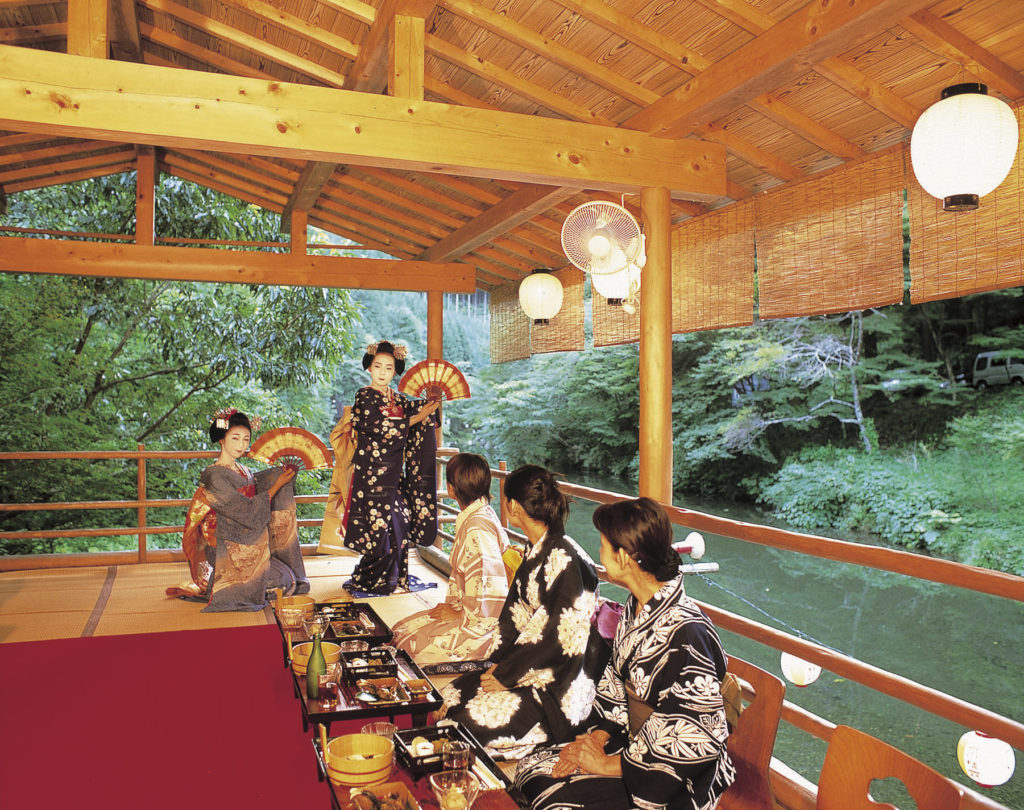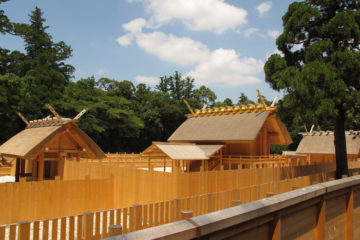Kyoto offers the traveler a range of beautiful sights to see and fascinating historical places to visit. The shining golden pavilion of Kinkaku-ji, the impressive, towering wooden structure of Kiyomizu-dera, the sprawling grounds and ornate interiors of Nijo Castle, the old geisha quarter Gion where you just might catch a glimpse of a geisha herself… The list goes on. These experiences are to be looked forward to, but what many visitors to this ancient city may not be expecting is how stiflingly hot and humid the summers here can be. However, like Kyoto’s many centuries old temples and shrines, this is not anything new, and the locals have long since found a way to beat the heat to relax and refresh in style. River terrace – or deck – dining is exactly what it sounds like. This traditional summer activity is when Kyoto riverside restaurants, tea houses, and cafes set up special open-air decks beside or even over the accompanying river. The open-air terraces afford diners not only a view of the river but also the refreshingly cool breeze of the evening in which to unwind and recover from the day’s heat. Seating consists typically of tatami mats with floor cushions and low tables. The fare served is historically Japanese, but in more recent years restaurants specializing in other cuisines have started joining in the tradition, serving up Chinese, French, and even yakiniku where guests sear fresh cuts of meat over grills built into their tables. Along the famous Kamo River (Kamogawa, in Japanese) in Kyoto, these open-air river terraces are known as noryoyuka. Restaurants on the Kamogawa in Kyoto proper offer a variety of opportunities to enjoy noryoyuka, but there’s somewhere just outside the city that offers a distinctly different scene.

Many who have climbed one of the higher structures in the city will have undoubtedly noticed the surrounding mountains, and it is here that the small town of Takao can be found (not to be confused with Tokyo’s Mt. Takao). Takao shares its more metropolitan neighbor’s tradition of riverside terrace dining, but the vernacular here is slightly different: in Takao it is called kawadoko. The temperature here tends to be a few degrees lower than Kyoto proper, and the verdant mountain landscape provides a completely different atmosphere from that of the old capital’s restaurant, townhouse, and temple-lined lanes. There are a number of establishments offering the kawadoko experience to the slightly more intrepid visitor, and Momijiya is one such establishment. Momijiya is a ryokan – a traditional style Japanese inn – located just outside Kyoto in the wooded heart of Takao. The ryokan is actually split into the honkan, the original (main) wing, which sits atop a valley, and the bekkan, or annex, which is situated further down the side of said valley. Momijiya’s scenic kawadoko are located all the way at the bottom of the valley, nestled snugly into the fresh green forest beside a pristine mountain river. Getting there is a bit of a journey itself, starting with catching a shuttle from central Kyoto. After winding its way up out of the basin in which Kyoto sits and then abruptly down to the bottom of a small valley, the shuttle stops at a curious wooden suspension footbridge across a river. On the opposite bank stand the riverside terraces – the kawadoko – of Momijiya.

The kawadoko are adorned by strings of lanterns which flicker to life as the early evening fades into twilight, and the scent of katori senko – coils of mosquito repelling incense – wafts through the air as guests make their way to their seats, where the first few dishes of the Japanese style meal are already laid out. As diners enjoy each other’s company and gaze out at the refreshingly green scenery with the river murmuring softly below, the announcement comes that the evening’s special entertainment has arrived. Soon after, shuffling along in tightly wrapped kimono, come the maiko.
Kyoto is famous for many things, and one very special aspect of its history that remains to this day is its geisha culture. The younger, apprentice geisha are referred to as maiko, and at Momijiya’s kawadoko, guests can look forward to a pair of maiko visiting during the meal. This is quite a rare opportunity as booking a party with geisha or maiko can be rather difficult for the uninitiated. The maiko make their way from table to table, stopping to chat and pose for pictures. Those knowing a little of the Japanese language may pick up on the unique Kyoto dialect spoken by the maiko, and none can help but marvel at their gorgeous silk kimono, their striking makeup, and their painstakingly arranged and decorated hair. After making the rounds to each table, the maiko perform a traditional dance for the kawadoko guests as they finish their meals.

Both Kyoto’s noryoyuka and Takao’s kawadoko welcome guests from the beginning of May to the end of September. As the activity is very popular for locals and domestic tourists, advance reservations are highly recommended and may be required at some establishments. Consult your hotel concierge or the tourist information center for advice and help. Evening tours to Momijiya’s kawadoko in Takao, including shuttle service from central Kyoto is also available.



0件のコメント